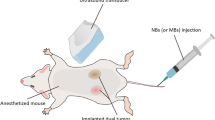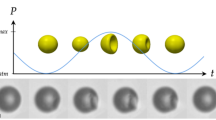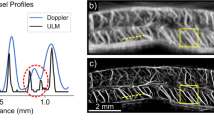Abstract
Not all bubbles in the bloodstream are detrimental. During the past decade, contrast-enhanced ultrasound has evolved from a purely investigational tool to a routine diagnostic technique. This transformation has been facilitated by advances in the microbubble contrast agents and contrast-specific ultrasound imaging techniques. The ability to non-invasively image molecular events with targeted microbubbles is likely to be important for characterizing pathophysiology and for developing new therapeutic strategies in the treatment of cardiovascular and neoplastic diseases.
This is a preview of subscription content, access via your institution
Access options
Subscribe to this journal
Receive 12 print issues and online access
$209.00 per year
only $17.42 per issue
Buy this article
- Purchase on Springer Link
- Instant access to full article PDF
Prices may be subject to local taxes which are calculated during checkout





Similar content being viewed by others
References
Rayleigh, L. On the pressure developed in a liquid during the collapse of a spherical cavity. Phil. Mag. 34, 94–98 (1917).
Dayton, P. A., Morgan, K. E., Klibanov, A. L., Brandenburger, G. H. & Ferrara, K. W. Optical and acoustical observations of the effects of ultrasound on contrast agents. IEEE Trans. Ultrason. Ferroelect. Freq. Contr. 46, 220–232 (1999).
Medwin, H. Counting bubbles acoustically: a review. Ultrasonics 15, 7–13 (1977).
DeJong, N., Hoff, L., Skotland, T. & Bom, N. Absorption and scatter of encapsulated gas filled microspheres: theoretical considerations and some measurements. Ultrasonics 30, 95–103 (1992).
Leong-Poi, H. et al. Influence of microbubble shell on ultrasound signal during real-time myocardial contrast echocardiography. J. Am. Soc. Echocardiogr. 15, 1269–1276 (2002).
Chomas, J. E., Dayton, P., Allen, J., Morgan, K. & Ferrara, K. W. Mechanisms of contrast agent destruction. IEEE Trans. Ultrason. Ferr. Freq. Control 48, 232–248 (2001).
Gramiak, R. & Shah, P. M. Echocardiography of the aortic root. Invest. Radiol. 3, 356–366 (1968).
Feinstein, S. B. et al. Two-dimensional contrast echocardiography, I: in vitro development and quantitative analysis of echo contrast agents. J. Am. Coll. Cardiol. 3, 14–20 (1984).
Christiansen, C., Kryvi, H., Sontum, P. C. & Skotland, T. Physical and biochemical characterization of Albunex, a new ultrasound contrast agent consisting of air-filled albumin microspheres suspended in a solution of human serum albumin. Biotechnol. Appl. Biochem. 19, 307–320 (1994).
Epstein, P. S. & Plesset, M. S. On the stability of gas bubbles in liquid-gas solutions. J. Chem. Phys. 18, 1505–1509 (1950).
Hundley, W. G. et al. Administration of an intravenous perfluorocarbon contrast agent improves echocardiographic determination of left ventricular volumes and ejection fraction: comparison with cine magnetic resonance imaging. J. Am. Coll. Cardiol. 32, 1426–1432 (1998).
Rainbird, A. J. et al. Contrast dobutamine stress echocardiography: clinical practice assessment in 300 consecutive patients. J. Am. Soc. Echocardiogr. 14, 378–385 (2001).
Kono, Y. et al. Carotid arteries: contrast-enhanced US angiography. Radiology 230, 561–568 (2004).
Fischer, G., Rak, R. & Sackmann, M. Improved investigation of portal-hepatic veins by echo-enhanced Doppler sonography. Ultrasound Med. Bio. 24, 1345–1349 (1999).
Prefumo, F. et al. The sonographic evaluation of tubal patency with stimulated acoustic emission imaging. Ultrasound Obstet. Gyn. 20, 386–389 (2002).
Darge, K. et al. Contrast-enhanced harmonic imaging for the diagnosis of vesicoureteral reflux in pediatric patients. Am. J. Roentgenol. 177, 1411–1415 (2001).
Lindner, J. R., Song, J., Jayaweera, A. R., Sklenar, J. & Kaul, S. Microvascular rheology of Definity microbubbles following intra-arterial and intravenous administration. J. Am. Soc. Echocardiogr. 15, 396–403 (2002).
Wei, K. et al. Quantification of myocardial blood flow with ultrasound induced destruction of microbubbles administered as a constant venous infusion. Circulation 97, 473–483 (1998).
Wei, K. & Lindner, J. R. Myocardial contrast echocardiography. Curr. Probl. Cardiol. 27, 449–520 (2002).
Wei, K. et al. Quantification of total and regional renal blood flow using contrast-enhanced ultrasonography. J. Am. Coll. Cardiol. 37, 1135–1140 (2001).
Rim, S. J. et al. Quantification of cerebral perfusion with real-time contrast-enhanced ultrasound. Circulation 104, 2582–2587 (2001)
Christiansen, J. P., Leong-Poi, H., Amiss, L. R., Drake, D. B. & Lindner, J. R. Assessment of skin flap viability by dermal perfusion imaging with contrast-enhanced ultrasound. Ultrasound Med. Bio. 28, 315–320 (2002).
Dawson, D. et al. Assessment of capillary recruitment in skeletal muscle using contrast-enhanced ultrasound. Am. J. Physiol. 282, E714–E720 (2002).
Kassab, G. S., Lin, D. H. & Fung, Y. B. Topology and dimensions of pig coronary capillary network. Am. J. Physiol. 267, H319–H325 (1994).
Rim, S. J. et al. Decrease in coronary blood flow reserve during hyperlipidemia is secondary to an increase in blood viscosity. Circulation 104, 2704–2709 (2001).
Ferrara, K. W. et al. Evaluation of tumor angiogenesis with US: imaging, Doppler, and contrast agents. Acad. Radiol. 7, 824–839 (2000).
Wilson, S. R., Burns, P. N., Muradali, D., Wilson., J. A. & Lai, X. Harmonic hepatic US with microbubble contrast agent: initial experience showing improved characterization of hemangioma, hepatocellular carcinoma, and metastasis. Radiology 215, 153–161 (2000).
Lindner, J. R. et al. Microbubble persistence in the microcirculation during ischemia-reperfusion and inflammation: integrin- and complement-mediated adherence to activated leukocytes. Circulation 101, 668–675 (2000).
Lindner, J. R. et al. Noninvasive ultrasound imaging of inflammation using microbubbles targeted to activated leukocytes. Circulation 102, 2745–2750 (2000).
Christiansen, J. P. et al. Non-invasive imaging of myocardial reperfusion injury using leukocyte-targeted contrast echocardiography. Circulation 105, 1764–1767 (2002).
Weller, G. E. R. et al. Ultrasound imaging of acute cardiac transplant rejection with microbubbles targeted to intercellular adhesion molecule-1. Circulation 108, 218–224 (2003).
Demos, S. M. et al. In vivo targeting of acoustically reflective liposomes for intravascular and transvalvular ultrasonic enhancement. J. Am. Coll. Cardiol. 33, 867–875 (1999).
Lindner, J. R. et al. Ultrasound assessment of inflammation and renal tissue injury with microbubbles targeted to P-selectin. Circulation 104, 2107–2112 (2001).
Unger, E. C., McCreery, T. P., Sweitzer, R. H., Shen, D. & Wu, G. In vitro studies of a new thrombus-specific ultrasound contrast agent. Am. J. Cardiol. 81, 58G–61G (1998).
Lanza, G. M. et al. A novel site-targeted ultrasonic contrast agent with broad biomedical application. Circulation 95, 3334–3340 (1997).
Tachibana, K. & Tachibana, S. Albumin microbubble echo-contrast material as an enhancer for ultrasound accelerated thrombolysis. Circulation 92, 1148–1150 (1995).
Porter, T. R., Kricsfeld, D., Lof, J., Everbach, E. C. & Xie, F. Effectiveness of transcranial and transthoracic ultrasound and microbubbles in dissolving intravascular thrombi. J. Ultrasound Med. 20, 1313–1325 (2001).
Leong-Poi, H., Christiansen, J., Klibanov, A. L., Kaul, S. & Lindner, J. R. Non-invasive assessment of angiogenesis by ultrasound and microbubbles targeted to αv-integrins. Circulation 107, 455–460 (2003).
Ellegala, D. B. et al. Imaging tumor angiogenesis with contrast ultrasound and microbubbles targeted to αvβ3 . Circulation 108, 336–341 (2003).
Hynynen, K., McDannold, N., Vykhodtseva, N. & Jolesz, F. A. Non-invasive opening of BBB by focused ultrasound. Acta Neurochir Suppl. 86, 555–558 (2003).
Shohet, R. V. et al. Echocardiographic destruction of albumin microbubbles directs gene delivery to the myocardium. Circulation 101, 2554–2556 (2000).
Tamiyama, Y. et al. Local delivery of plasmid DNA into a rat carotid artery using ultrasound. Circulation 105, 1233–1239 (2002).
Christiansen, J. P., French, B. A., Klibanov, A. L., Kaul, S. & Lindner, J. R. Targeted tissue transfection with ultrasound destruction of plasmid-bearing cationic microbubbles. Ultrasound Med. Bio. 29, 1759–1767 (2003).
Porter, T. et al. Inhibition of carotid artery neointimal formation microbubbles. Ultrasound Med. Bio. 27, 259–265 (2001).
Bao, S., Thrall, B. D. & Miller, D. L. Transfection of a reporter plasmid into cultured cells by sonoporation in vitro. Ultrasound Med. Biol. 23, 953–959 (1997).
Greenleaf, W. J., Bolander, M. E., Sarkar, G., Goldring, M. B. & Greenleaf, J. F. Artificial cavitation nuclei significantly enhance acoustically induced cell transfection. Ultrasound Med. Biol. 24, 587–595 (1990).
Unger, E. C., Hersh, E., Vannan, M., Matsunaga, T. O. & McCreery, T. Local drug and gene delivery through microbubbles. Prog. Cardiovasc. Dis. 44, 45–54 (2001).
Author information
Authors and Affiliations
Ethics declarations
Competing interests
J.R.L. is a scientific advisory board member for Bristol-Myers Squibb Medical Imaging, and is a minority owner of Targeson, LLC.
Rights and permissions
About this article
Cite this article
Lindner, J. Microbubbles in medical imaging: current applications and future directions. Nat Rev Drug Discov 3, 527–533 (2004). https://doi.org/10.1038/nrd1417
Issue Date:
DOI: https://doi.org/10.1038/nrd1417
This article is cited by
-
Ultrasound and nanomaterial: an efficient pair to fight cancer
Journal of Nanobiotechnology (2022)
-
A new bubble generator for creation of large quantity of bubbles with controlled diameters
Experimental and Computational Multiphase Flow (2022)
-
Cellulose nanocrystal-based enhancement of ultrasound microbubbles for increased tolerance of mechanical index values
Cellulose (2022)
-
Quantitative analysis of in-vivo microbubble distribution in the human brain
Scientific Reports (2021)
-
Ultrasound-propelled Janus Au NR-mSiO2 nanomotor for NIR-II photoacoustic imaging guided sonodynamic-gas therapy of large tumors
Science China Chemistry (2021)



